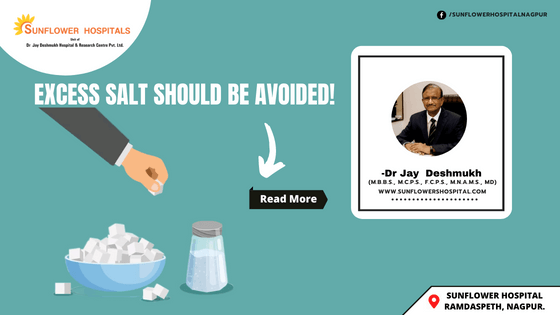What should be the ideal salt intake?
Most people consume too much salt. On average, an adult consumes 9 -12 grams of salt per day. However, the average salt intake should be less than 5 grams per day.
What are the benefits of low salt intake?
Salt intake of fewer than 5 grams per day for adults helps to reduce blood pressure and risk of cardiovascular disease, stroke, and coronary heart disease. World Health Organisation member states have agreed to reduce the salt intake by 30% in every individual by 2025.
Why has salt consumption increased?
Eating more processed foods, rapid urbanization, changing lifestyles, and excess consumption of salt, sugar and trans fats all contribute to increased sodium intake. Consuming fewer fruits and vegetables and less dietary fibre is another Health experts agree that excess salt in the diet is dangerous. It can affect your health adversely but surely. Excess salt consumption can lead to short-term and long-term deleterious effects on our health. In March, we have World Salt awareness week. An estimated 2.5 million deaths can be prevented each year if global salt consumption were reduced to recommended levels. The WHO recommends 2000 mg of Sodium per day, this is less than 5 grams of salt per day.
A key component of malnutrition. Fruits and vegetables contain potassium, which contributes to reduce blood pressure.
What are the short-term effects of too much salt in your diet?
Excess salt leads to excess water retention. As a blot-ting paper attracts ink, so also salt would attract water retention. This can lead to bloating. A sudden rise in blood pressure may be linked to excess salt consumption. This is common in the elderly and those with kidney disorders.
What about heart disease and salt intake?
With every 1 grain of extra sodium in the diet, the risk of heart disease increase by 6%. Another study found that people who consume more salt may have a higher risk of death than those who consume less salt.
What are the common food items rich in salt?
The most important is table salt. You should not have table salt on your dining table. Excess salt is present in pickles, papas, and chutneys. Salted popcorn, potato chips, and packaged snacks are other sources of salt that are rich in Sodium. Bread, biscuits, noodles, and burgers are other sources of excess salt.
Is pink salt better than table salt?
Table salt is heavily processed to remove impurities. This also removes significant trace elements. Pink salt is healthier than table salt. It contains minerals like potassium, magnesium, calcium, and iron.
Can too much salt be responsible for osteoporosis?
Sodium prevents the absorption and utilization of calcium, leading to brittle bones. Women after menopause, the elderly, and those with osteoporosis or chronic kidney disorders are at increased risk. Salt is a necessary component of our metabolism. Too little or too much salt can be deleterious. Next time you are reaching for the salt, think about the amount you need. You should make an effort to reduce your salt consumption. The WHO recommends 2000 mg of Sodium per day, this is less than 5 grams per day.
Author: Dr Jay Deshmukh
Dr Jay Deshmukh is Chief Physician and Director, Sunflower Hospital, Nagpur Honorary Physician to Honorable Governor of Maharashtra and PondicherryCentral. Dr Jay Deshmukh is an M.B.B.S., M.C.P.S., F.C.P.S., M.N.A.M.S., MD From Internal Medicine – Bombay and New Delhi.


